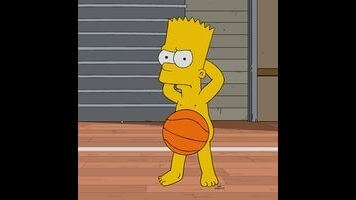There’s no reason why a plot about Bart getting in with the Mob over sports betting couldn’t be a ”regular” episode, but “22 For 30” moves through the expected story beats at an entertainingly brisk clip, the change in format allowing for plenty of good—and different—jokes to sneak into the corners of the screen. Chyrons introducing the characters we know and love are used to fine, fleeting effect. According to the film, Superintendent Chalmers was a founding member of Steely Dan, Lisa (who eventually cracks the Fat Tony story) is a “hard-nosed journalist, 8 p.m. bedtime,” and Skinner rents his neckties. Similarly, the old spinning newspaper montage sees Bart’s meteoric rise announced in headlines like “D-Student Knows O-ffense,” and “Boy Scores 50, On Court And On Test.” And the episode makes judicious use, in a few cases, of quick editing to make jokes work. When Marge talks to camera about helping Bart any way she can, the shot of her with a basketball hoop mounted in her signature sky-high hairdo gets a laugh, as does the offscreen, “What the..?” when Bart’s showing off his naked basketball-spinning trick. (Don’t ask.) On a normal episode, such gags wouldn’t work, or they’d at least call too much attention to their randomness. Here, they’re unobtrusively funny.
The Simpsons used to be outstanding at wringing heart from absurdity—or of balancing heart and absurdity. It’s something that, more than anything else, marks out the gap between “the good years” and current Simpsons. (There are exceptions, and they’re like finding an oasis.) “22 For 30” doesn’t attempt the feat, instead calling attention to how all the heartwarming or heartbreaking of the average “reality”-based entertainment is largely a product of manipulatively streamlining the complexity of a life into a preordained mold. The episode sees various characters attempting to wrest the narrative their way, with Homer and Bart laying claim to ”tragic protagonist” status. Bart, nodding to the camera’s expectations, says, “I guess this is the part where I start to cry,” while Homer displays one of his inexplicable bursts of obscure knowledge, this time about self-aggrandizing camera moves. (“Tighten on him, then rack-focus to me!”) And Lisa, doggedly pursuing the truth of the growing Bart-Fat Tony scandal, keeps futilely pitching her own importance, but keeps getting the brush-off. (Another fast edit cuts away from her desperate attempt to hold focus with her saxophone skills.)
All this is breezy stuff, unencumbered by much in the way of emotional stakes or the need to wrap things up in an emotionally or dramatically neat manner. Indeed, the final joke sees Nelson, of all people, getting the last word, as the throwaway subplot about his deadbeat dad culminates in a heartwarming (if short-lived) reunion with… the narrator. “22 For 30” is mostly just about the jokes, which hit with pleasing regularity. Milhouse attempts to speak undercover via voice-disguising distortion, but gets too scared of his modulated monster voice to continue. Skinner introduces Coach Homer as “volunteer, and Bart’s owner.” All the point-shaving graft makes for the reveal that Bart’s new clubhouse is made of nothing but ill-gotten flat screen TVs. Fat Tony, despite the best, muttered efforts of his sleazy lawyer (Springfield’s ubiquitous sleazy lawyer guy) keeps on-camera threatening “or else” to everyone in sight while trying to deny he’d “or else-d” Bart. Grandpa’s long-winded story stops mid-stream, and the narrator announces, “This is not a video trick—he really just stopped moving.”
If this review sounds a lot more like a list of gags better suited to the stray observations, well, that’s correct. “22 For 30” is a fun trick that takes the show temporarily out of its usual patterns. It doesn’t expand on the trick, or stretch its boundaries, but it’s a neat trick, nonetheless.
Stray observations
- According to restauranteur Luigi, his cannoli are “like eating the bone marrow of an angel.”
- “He’d had something he’d never had before. Enough.”
- Lisa saves the day by threatening to expose Fat Tony’s shameful childhood as “the third-string shooting guard” of a girls basketball team.
- Other uncomfortable secrets about Fat Tony, according to Legs: He wears man spanx, he’s secretly seeing a shrink, his old nickname was “Robert De Zero,” and he cried at Toy Story 2. (“That’s not even the sad one!”)
- Another, more tight-lipped Fat Tony associate is Johnny Tightlips. Real name: Giovanni Silencio.
- The whole basketball frame hits the expected beats. Bart runs from the furious Homer, exclaiming that he’s taking his talents to Shelbyville. Coach Homer bites towels, a la Jerry Tarkanian. (Homer smeared jelly on his.) Homer also tosses chairs like Bobby Knight, etc.
- “Bart, I’m your coach, your father, and, because no one else would, your godfather.”
- “Thanks dad, but don’t you still make mistakes?” “And the best one was you, son.”
- Bart: “I was scared, Milhouse-scared.” Milhouse: “Why do you keep cutting to me?”
- Bart’s basketball mastery is explained away by saying it evaporated once he went up against his first tall opponent.
- The talking head format leads to a Mr. Burns-as-Robert-Durst gag, where he accidentally confesses to murder while wearing his live microphone. Still, this is a clever joke: Smithers—“You’re on-mike, sir.” Burns—“Who is this Mike? I’ll kill him, too!”
- The inventive hand-drawn couch gag was from legendary animator Bill Plympton.


 Keep scrolling for more great stories from A.V. Club.
Keep scrolling for more great stories from A.V. Club.